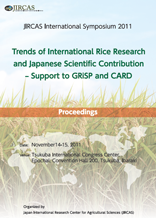Breeding of High-Yielding Rice Varieties in Japan

There are two major series of projects for the breeding of high-yielding rice varieties in Japan. The first series
of projects are so called “Super Rice projects” in which we tried to develop super high yielding rice varieties
by using a wider genetic background of rice varieties including Indica type rice. They were initiated in the
beginning of 1980s and completed in the middle of 1990s. Before them the usages of Indica genetic resources
were limited in Japan. Through the first projects the usage of Indica types was advanced and we developed
varieties like Takanari and Akenohoshi. The second series of projects were started around year 2000 and have
been continued to the present. The main purpose of those projects is to develop the varieties for animal feed.
Over-production of rice has been a problem for the past 40 years in Japan. On the other hand, there is also a
need for an increase in the production of domestic grain and bulk feed in Japan. Grain feed and whole crop
silage (WCS) rice for bulk feed have being promoted by the government. For WCS the whole aerial parts
consisting of grains, leaves and stems are harvested at the yellow ripening stage. At present, about 24 grain
feed and WCS rice varieties have been bred and are commonly used in Japan. More than 8ton/ha grain
yields have been achieved by several high yielding varieties such as Mochidawara, Hokuriku 193 and
Momiroman. Their yields are up to 38 percent higher than control ordinary rice varieties for human. For WCS
the total digestible nutrients (TDN) yields were around 12ton/ha which were similar to the yield of forage
maize. Their TDN yields were 3 to 27% higher than those of ordinary rice varieties.
The lodging resistances of most of the grain feed and WCS varieties are “High” and this trait is essentially
important. By using a larger amount of fertilizer or manure application than ordinary rice varieties for human,
those high yielding varieties can achieve high yields of grain and whole crop. Varieties for animal feed have
wider genetic background and their ratios of Indica and Japonica vary from one variety to another.
| Date of issued | |
|---|---|
| Creator | Hiroshi Kato |
| Subject |
High-yielding rice grain yield total digestible nutrients (TDN) yield animal feed lodging resistance Indica and Japonica |
| Publisher | Japan International Research Center for Agricultural Sciences |
| Available Online | |
| Issue | 2011 |
| spage | 55 |
| epage | 62 |
| Rights | Japan International Research Center for Agricultural Sciences |
| Language | eng |
